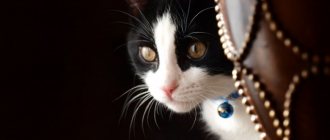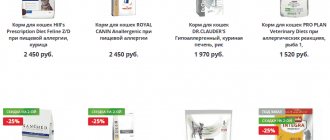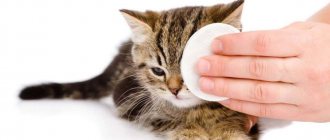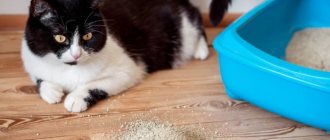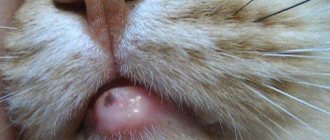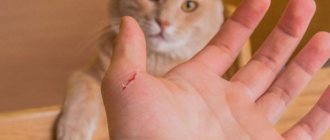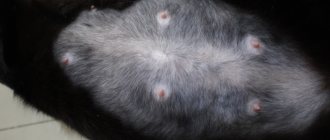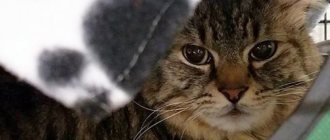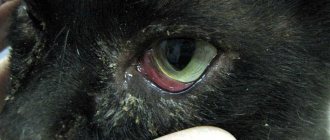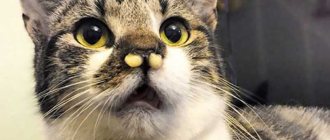Preventing hair loss in cats
Seasonal molt
Beginning cat owners often panic when their cat begins her first seasonal shedding.
This usually occurs in spring and autumn. The behavior does not change, the cat is playful, the eyes are healthy and shiny, the nose is moist. Cats have a very delicate digestive system. Many owners love to feed their pet from their table, and then are surprised by the cat’s health problems. Human food flavored with spices, flavorings and salt is contraindicated for cats, as it causes severe hair loss - dermatitis. Excessive hair loss occurs. The cat's appetite worsens, it becomes lethargic and inactive.
If this problem occurs, you should put the cat on a diet: low-fat fish, kidneys, liver, cottage cheese. Give milk twice a week as independent nutrition. Vitamins containing biotin, B vitamins, antiallergic (tavegil or suprastin) and anthelmintic drugs are needed.
Hormonal disorders are also caused by special drops or tablets against the sexual desire of cats. Such drugs have a negative effect on the body and lead to diseases of the pet’s internal organs.
Dermatitis also occurs due to a cat’s reaction to a variety of synthetic substances, for example, to the product the owner uses to clean furniture, aerosols - air fresheners, or even to indoor plants.
If the fur begins to fall out in clumps, and round pink bald spots appear on the skin of cats, then you should think about the manifestation of the disease lichen. This disease is caused by a species of microscopic fungus. Ringworm is a highly contagious disease that also affects humans.
A cat can also become infected with skin mites. Hair loss is severe on the face, behind the ears and on the paws, and ulcers appear on the skin. The pet may even go bald.
You should definitely consult a doctor. After all, treatment takes place with toxic drugs and only a specialist can choose them correctly. Skin mites are not dangerous to humans. But the apartment should still be disinfected, and it is advisable to burn the cat’s bedding.
If your cat has been ill with any disease, then the immune system decreases and the hair begins to fall out. It is necessary to purchase special B vitamins for your pet and choose the right diet for the active development of the cat.
Nervous stress
Cats are very smart animals. They perceive current events very sensitively and can easily go into a stressful state. The reason may be moving to another place, for example, to the country in the summer. Death of the owner or any animal. The appearance of a new pet.
The cat's reaction to stress is manifested by hair loss, the cat spends more time washing itself. You should visit a doctor to really make sure that your cat is stressed and not sick.
The best way to relieve stress is simple affection, which needs to be given much more time. Medicines with a calming effect prescribed by a doctor will help.
Old age
As a cat ages, it begins to lack vitamins and essential minerals. All this is reflected in the fur; it begins to fall out in large areas.
It is worth mixing vitamins and nutritional supplements into food. There are various medicated foods on sale that will quickly help rid your cat of hair loss.
Caring for a cat's fur involves daily brushing. It is advisable to teach this from childhood, then it becomes a pleasant procedure for your pet. Brushing cleans the coat of dirt and hairs that have already fallen out. This is a kind of skin massage that improves blood circulation.
Proper nutrition
Organize your pet the right diet, add age-appropriate vitamins and mineral supplements to a varied diet. Do not overfeed older cats.
Be sure to vaccinate your cat against various skin diseases. A veterinarian will select preventative vaccines for you; they are individual for each cat.
Take care of your pet, feed it properly and brush it regularly, and your beloved cat will delight you with its health and beautiful fur coat!
The process by which the integument of animals changes is called molting. This occurs under the influence of a special hormone, most often in spring and autumn. The owners of such pets must be very observant so as not to miss the moment when your home is completely covered with fur.
Video review about cat shedding: an interview with a breeder and grooming expert about caring for a cat’s fur
- How to properly comb a cat?
- What to do if your cat sheds heavily all year round?
- Why do cats have more combs than people?
– Why do British cats shed? Cats typically shed twice a year.
If a cat sheds all year round, then the cat has health problems: 1. Worms .2. Disorders of the gastrointestinal tract.3. Problems with the pancreas.4. Liver problems.5. The cat is in constant stress (it is very afraid of something or someone, manipulations are often performed on it that it does not like).6. Problems with the anal sinuses .7. Lack of vitamins.
Your actions:
1. Give anthelmintic drugs2. Submit feces for clinical analysis.3. Donate blood for biochemical analysis.4. Remove sources of stress5. Empty the anal sinuses6. Introduce a complex of vitamins into your cat’s diet7. Show the cat to the doctor.
– Why do the British’s eyes water (run)?
Excessive tear production from the eye occurs in cats for several reasons:
1. Helminthic infestation. There are worms that pass one of the stages of their development in the lacrimal sac of the eye.2. Allergic reaction to a component of the external environment.3. Eye irritation, such as from tobacco smoke.
Your actions:
– Why is the British cat thin?
– Why are British cats angry?
Cats are most likely to become aggressive when they become distressed.
1. Stress develops with severe pain, with forced contact with a person. The owner often takes the cat in his arms and strokes it often. Children often forcefully touch the cat.2. New circumstances in a cat's life. The cat was moved to a new apartment, taken away from the dacha, and a new family member appeared in the family.3. Stress also develops in chronic diseases associated with pain.
Your actions:
Be sure to contact a zoopsychologist.
– Why does the British cat bite?
Cats bite in several cases:
1. Kittens up to 5 months old bite due to the hunting instinct, which is genetically inherent in cats. The need to bite in kittens subsides by the age of six months. This is especially true for their owners. The hunting instinct of adult healthy cats does not extend to people.2. Adult cats bite humans when they are under severe chronic stress.
Your actions:
1. Keep the kitten healthy and energetic
Everyone knows that representatives of the cat family periodically shed their hair, mostly seasonally. This process is called molting, and it is completely natural, so there is no reason to panic. This article will help you find out what to do when a British cat sheds heavily.
Take care of your coat
You are a caring housewife. You do everything for the beauty of your mustachioed friend. Do not forget that if washing the cat does not solve the problem (with excessive shedding), then a special conditioner will restore the fur that is damaged. It will also eliminate dryness of the cat’s skin and relieve it from flaking.
Due to their short hair, Scottish cats (or Scottish shorthair cats) do not require any complex care for their coat. True, during the period of hair loss, cats need to be combed more often to remove dying pieces of hair and provide an incentive for the growth of new ones.
In a situation where a cat sheds heavily, “what should I do?” - this is a very serious question. After all, the cat licks itself, and can thus swallow pieces of fur. Fur balls will accumulate in her stomach. The animal may vomit or the accumulated hair may cause an intestinal blockage.
Outdoor cats, for example, cope with this complication simply - they eat grass. And the family members try to nibble flowers and other indoor plants. Not understanding the reason for this, the owners simply drag them away from the green spaces.
Be careful when your Scottish cat sheds heavily. What to do? Consult a veterinarian, because the wrong decision can harm your pet.
By the way, food manufacturers today produce them with such ingredients that they prevent balls of hair that have entered the cat’s stomach from rolling off. Moreover, they facilitate their natural elimination from the body. Of course, natural green grass is healthier and more effective. Therefore, in the summer, let your cat out for a walk and enjoy the street grass to his heart's content. Or grow it at home.
Pet stores sell special pastes. They help remove hair from the cat's stomach. They can be used too.
Hair, especially in long-haired cats, can also accumulate behind the lower canines. The animal itself, of course, cannot get them. This is your concern. Otherwise, inflammation may occur.
About intense shedding in cats
Seasonal renewal of fur in cats is repeated in spring and autumn. At the same time, in representatives of long-haired breeds it falls out in whole clumps. Cats with missing undercoat shed less.
However, sometimes the process of fur coat renewal can be too pronounced in cats. No one can react indifferently to a situation when a Scot leaves whole clumps of his fur on the floor, chairs and other places. This is a concern for a responsible owner. He wonders why this is happening. Most often, this is caused by a deficiency of Omega-3 and Omega-6 fatty acids in the cat’s menu. Her body cannot produce these substances on its own. A deficiency of the above components is observed when the animal is treated with purely natural food. And when it consumes dry food of good quality, such a problem does not arise, since they contain the above-mentioned fatty acids in the required quantity. A lack of other minerals and vitamins also leads to intense hair loss in your pet. Sometimes they are simply not absorbed by the animal’s body. In this case, we are probably talking about hormonal imbalances, problems with the adrenal glands or thyroid gland, causing pathological molting.
Stress is another equally common cause of intense hair loss in cats. Representatives of exotic breeds of cats are very sensitive to a change in situation, owner, moving, physical punishment, and the appearance of a child in the family. Their body reacts to such situations with protest in the form of severe molting. Injuries are also a stress factor. Sometimes, despite seeming external well-being, an animal begins to shed intensively after falling from a height.
There are many diseases, a sign of which can also be severe hair loss. These are lichens, leukemic infection, allergic dermatitis. It can manifest itself in food components, medicines and hygiene products.
Pathological shedding in a Scottish cat goes away when its owner cures the cause that caused it. And you shouldn’t scold the cat, because he doesn’t shed his coat on purpose.
Seasonal shedding and normal hair loss
The Scots have a thick and beautiful coat. It may fall out in spring or autumn due to changing climatic conditions. The period of seasonal molting in cats lasts 1-2 months. Cooling or warming weather, changing the length of daylight hours - all this affects the condition of the cat's hair.
When an animal constantly lives indoors and does not go outside, its body does not feel sudden changes, so the change of seasons is not so pronounced. In such cases, hair loss can occur year-round, slightly increasing or decreasing.
When shedding is associated with the seasons, it does not cause thinning of the coat or areas of baldness. There is no need to go anywhere, just take measures to clean, moisten the apartment and remove hairballs from the animal’s body.
The cat's hair is constantly falling out in clumps, all year round, in summer and winter: reasons
The causes of excessive hair loss, which is permanent, can be very different. However, they all indicate one thing: not everything is in order with the animal’s body. Let's look at it in order:
Lack of vitamins. The cat's diet should be balanced. Special food contains a certain amount of vitamins that are necessary for the cat’s body.
If you feed your cat natural products, pay attention to the diversity of the diet. Sometimes, due to an unbalanced diet, cats develop allergies or dermatoses. Hormonal disbalance
Often, owners suppress the cat’s sexual desire with special drugs. In this case, hormonal imbalance may occur. Along with hair loss, hormonal imbalance reveals itself through the following signs: cat apathy, reluctance to approach the food bowl, weakness, unusual behavior. Lichen. Round bald spots appear on the animal's body; the skin in these places may be reddened or too white, and there may also be scales. In this case, a visit to the veterinarian is extremely necessary, since the disease is dangerous, not only the animal suffers, but people can also become infected. Skin mites and helminths. A sign of skin mites is baldness of the face, paws, and ears. Pay attention to how often your cat itches. Helminths are also a serious problem; they have a detrimental effect on the functioning of internal organs and externally manifest themselves in the form of dermatoses.
It is a mistake to think that worms or skin mites cannot appear in a cat that does not go outside. Even if a cat does not eat raw meat, it is not a fact that it will not become infected with worms. These parasites can be brought into the house on shoes or clothes.
Dermatomycosis in cats
Important: Another cause of hair loss in cats can be stress. Like people, cats are prone to anxiety and overstimulation of the nervous system.
What may seem insignificant to a person may be perceived as painful by a cat. This includes physical and emotional factors.
Physical stress factors:
- Electric shock;
- Burns;
- Injuries;
- Past illnesses.
Emotional factors:
- Moving to a new place;
- The appearance of new residents (animals or people) in the house;
- Loss of owner;
- Restriction of freedom.
These or other events may not necessarily cause hair loss and deterioration of the cat’s condition, but it is still worth paying attention to the nervous shock of your beloved pet
Hair can be shed all year round
What does a British cat need in an apartment?
Before bringing your Briton to a new place of residence, prepare all the necessary accessories for him:
- Sleeping area. Decide in advance where your pet will sleep. Representatives of the British breed are quite independent and like to be alone, so it would be advisable to buy your pet its own bed or cat house.
- Tray. For the toilet, it is better to use a closed plastic tray. When purchasing, you should take into account the large dimensions of the British - the tray should be high and as comfortable as possible. It is better to use silica gel or wood filler; they absorb moisture well and prevent the occurrence of unpleasant odors.
- A bowl. A special drinking fountain or ceramic bowl is perfect for water. And for food, you should choose a tall metal bowl with a wide bottom.
- Scratching post. British cats do not want to spoil your furniture at all, they just love freedom very much. However, we all know how dangerous the street is for purebred animals. In order for your pet to be able to independently care for its claws in the apartment, it needs to purchase a scratching post or a play set.
- Comb. For the plush fur coat of the British, massage slicker brushes or oval rubber combs, which can remove static electricity, are best suited.
- Cloth. An additional accessory for your pet can be cool clothes that will not only emphasize the important appearance of the British cat, but will also warm you up during a walk in the cold. After all, short-haired cat breeds have a hard time withstanding frosty winters. Clothing for a British person should be comfortable, high quality and easy to wash.
Create a cozy atmosphere for your pet in your home, and then he will be able to feel at ease.
Wool is an indicator of a cat's health
The cat sheds a lot, what is the reason for this process, because shedding is a clear sign that not everything is going well for the cat?
When worms appear in cats, hair begins to fall out
A number of diseases lead to baldness in cats:
- Allergy. The most pressing disease of our time has not spared animals, who suffer just as much as humans. Allergic processes in cats can be triggered by inappropriate food or frequent treats, as well as cleaning products used in the house. Cat allergies are accompanied by itching, the animals become irritable and nervous, often itch, and traces of dandruff appear on the fur. Another sign of an allergy is watery eyes. To determine the cause of the allergy, it is worth changing the food and limiting the animal’s diet, eliminating various excesses. It also wouldn’t hurt to give an activated carbon tablet once a day.
- Worms. If the cat sheds a lot, the fur has become dull, there is an unpleasant odor from the mouth, and problems with the intestines are observed, the animal probably has a helminthic infestation. It is necessary to give the cat an anthelmintic recommended by a veterinarian, and repeat the procedure after 2 weeks. In the future, antihelminthic prophylaxis should be carried out at least once every 3 months.
- Fungal infections. Among them, the most dangerous disease for humans, transmitted from animal to owner, is ringworm. It is difficult for a non-specialist to recognize the types of fungal infections; for this purpose, a laboratory test is carried out and specific treatment is determined. Among the common signs:
- dandruff;
- dull coat;
- clear boundaries of bald patches;
- the hair breaks off in the middle;
- There may be sores and blisters on the skin.
Existing fleas and ticks cause severe itching, causing fur to fall out
The development of fungal infections is sometimes caused by excessive care of the owner, who scratches the cat too much - small scratches on the skin contribute to the development of a pathogenic environment. Frequently washing your cat also helps the fungus to appear. Only a specialist can completely cure a fungal infection by prescribing treatment, which may consist of antifungal ointments, sprays and medications or injections. It is better to start treating fungal diseases in time, especially if there is a small child in the house who does not often wash their hands after handling an animal.
- Skin parasites. Existing fleas and ticks cause severe itching - the cat actively itches and introduces infection into the wounds, and the hair begins to fall out. To eliminate skin parasites, there are single-use preparations that need to be dripped onto the animal’s withers.
- Hormonal problems. In adolescence, during pregnancy or after sterilization, the cat began to shed very much - this is how problems in the functioning of the internal organs (gonads, adrenal glands, thyroid gland) manifest themselves. To improve the condition of the animal, fatty acids should be added to the diet. It usually takes six months to restore hormonal levels after sterilization or pregnancy. While the cat is expecting kittens or feeding them, her diet must be supplemented with vitamin supplements.
Baby shedding, or When Scottish kittens change their fur
Does your Scottish cat have a lot of fur the first time? Perhaps this is the so-called baby molt. When do Scottish kittens' coats change from baby to adult? The first molt occurs when cats are 5-6 months old, give or take. At this age, within 1-2 months, the Scottish cat’s fur is growing so much that it seems as if there will be no end to this problem.
The molting period of a Scottish kitten will end, but it can smoothly transition into a calmer phase, the duration of which sometimes reaches a year. During this period, the teenager must gradually change the primary, soft fur given to him from birth with adult, coarser, denser and more contrastingly colored fur. At the end of the baby's molt, the fur becomes more beautiful, and the pattern required by the color appears in all its glory.
Why and how cats shed
Subsequently, molting will become regular. For cats, this is a natural process of preparing for the change of season. Ideally, a cat sheds twice a year:
- before the cold weather begins. Reducing daylight hours and a significant decrease in temperatures include protective mechanisms that involve a change in wardrobe. Cats are rapidly growing a new coat that can protect them from frost. For example, the British grow a powerful, dense undercoat, which is much thicker than the summer one;
- before the onset of heat. Rising temperatures make it necessary to prepare for the summer heat. “Winter” fur, having served its purpose, is no longer needed. Therefore, a lightweight version is growing.
Cats that have free range react most strongly to the change of seasons. Their bodies are exposed to natural weather conditions and are sensitive to the changing seasons.
Cats living in an apartment without walking, despite the lack of seasonality in the home climate, also shed. Only the time of this process is not strictly tied to the environment. Depending on the breed, cats shed 1-2 times a year.
It should be borne in mind that in mature, uncastrated cats, shedding can begin at any time as a reaction to certain changes in physiology. This is how the body will react to hormonal changes during estrus or after kittens are weaned from mother's milk. This is not a reason to panic, you just need to provide your cat with improved nutrition and vitamins.
Shedding all year round
There are cat breeds with thick undercoat. These are, for example, Siberian and British. They shed fur throughout the year. This comes naturally to them. Therefore, if nothing bothers you during the molting process, and there are no obvious changes in the fur, then there is no need to sound the alarm.
However, there are other reasons for this phenomenon. If a cat sheds a lot, what should you do in such cases?
Those animals that sit in an apartment all winter and are transported out of town in the summer, for example, to a dacha, are characterized by increased hair growth. It's warm outside, you can run freely everywhere. The fur is growing. And as soon as they return to urban housing, increased hair loss begins.
How long does seasonal molting last?
If you are scared by your kitten's long first molt, don't worry. This is due to complex processes of physiological maturation. Shedding in cats that can be called adults goes back to normal. On average it lasts a couple of months a year. Once in the spring, and again at the end of autumn. There may be minor time shifts in the schedule.
Usually short-haired pets fit into the schedule and timing of shedding. It’s more difficult with the fluffier ones. Persians or Maine Coons, after shedding their guard hairs, take a long time to get rid of the undercoat. They definitely won't be able to do it without your help. If you don't help them with their struggle, the consequences can be serious. From local tangles to completely matted fur.
Sometimes shedding in cats occurs unplanned or does not stop for a long time.
Who sheds more?
Often readers of the MURKOTIKI website ask who sheds more - a Siberian, Persian or Scottish cat? That is, they compare Scottish cats with longhaired breeds.
If we talk about Scottish Straights and Scottish Folds, that is, Scottish shorthair cats, they shed less noticeably, because their hair is shorter. X Island Straights and Highland Folds, that is, Scottish semi-longhair cats, also shed less than Persians and other long-haired cats, but more than Scottish cats.
Why does a Scottish cat shed a lot?
There are times when shedding is stronger than it should be, which threatens a deterioration in the quality of the coat and health and the torment of the owners, who will literally drown in the hair. The fact that shedding is excessive is indicated by the rapid deterioration of the coat and the formation of areas of baldness.
Before you begin to act, you need to find out the reason for the abnormally heavy shedding. To do this, you need to consult with a veterinarian, who may find some kind of disease in your pet.
The most common cause of severe shedding is poor nutrition, which lacks vitamins, microelements and fatty acids. To eliminate this problem, just read the information on how to properly balance the diet of a Scottish cat, and include vitamin complexes with Omega-3 and Omega-6 fatty acids in the diet.
However, it also happens that a cat receives all the vitamins, acids and microelements, but they are simply not absorbed. Most often this occurs due to hormonal imbalance, which, in turn, can be caused by cysts and tumors, poor functioning of the thyroid gland or adrenal glands. In this case, a veterinarian should take care of the treatment.
Methods for reducing hair loss
If there are no pathological causes of shedding that require immediate contact with a veterinarian, we will try to reduce it and correct the consequences.
The right diet
First of all, we will ensure that the cat’s body receives all the necessary substances. A pet's diet should include all the necessary macro- and microelements, vitamins and fatty acids. When eating only natural food, there may be a lack of Omega-3 and Omega-6, because... the body of a Scots cat does not produce these substances. A lack of vitamins is also possible.
Features of the British cat
The British cat was bred artificially by man. Using the selection method, almost “plush” animals were obtained that bring indescribable bliss to the owner. However, such cats have lost part of their resistance to diseases and the endurance inherent in their wild relatives. Therefore, they need to be given more attention and care.
Causes of shedding
There are several reasons:
- Seasonal molting occurs - in autumn and spring within one month. It `s naturally;
- Weakened immunity;
- Experienced stress;
- Pregnancy or postpartum period;
- Poor nutrition;
- Lack of vitamins and microelements;
- Allergic reaction to changing the type of food. For example, switching to dry food;
- Infection with one of the types of skin fungi;
- Hormonal imbalance due to a missed mating period or the use of hormonal drugs in the treatment of any disease;
- A serious disease that can only be diagnosed by a veterinarian.
What to do?
First of all, take care of the fur. Wash the cat with shampoos intended for this purpose, comb it and keep it in a room with a comfortable temperature. The coat should be smooth and shiny.
When changing these parameters, if the fur becomes dull and ruffled, immediately pay attention to nutrition. Is it complete and varied, are all the vitamins and microelements needed by your pet at different stages of life present?
After all, during pregnancy and especially after childbirth, you need a more carefully selected diet.
Special preparations and complexes are used, which are now abundant in veterinary pharmacies, making the coat delightfully soft and silky.
All possible stress factors are eliminated. Fluctuating temperature changes, unexpected loud sounds, encounters with other animals.
Even the appearance of strangers in the house can cause anxiety. British cats become very attached to their owners and experience serious shock in the presence of a stranger.
If the above conditions for caring for a British shorthair cat are met, the owner may not even notice how the seasonal shedding has passed.
If all the necessary precautions are taken, the threatening factors have been eliminated, but the animal continues to experience hair loss, then you just need to run to the veterinarian in order to prevent more serious consequences for your pet’s body. It’s worth starting with the fact that the molting process is a natural physiological manifestation in the life of a pet.
Almost everyone is susceptible to seasonality. Pets can shed at any time of the year, other cats only change their hair coat
It’s worth starting with the fact that the molting process is a natural physiological manifestation in the life of a pet. Almost everyone is susceptible to seasonality. Pets can shed at any time of the year; other cats only change their hair coat.
Are there any non-shedding cat breeds?
The desire to have a cat with a flowing coat can be realized without the exhausting struggle with shedding if it is possible to have a Burmese, American Curl, Somali or Turkish Angora.
Shorthaired Siamese, Abyssinians, Burmese, Bengals, Singaporeans, Egyptian Mau or Bombay cats will cause minimal problems.
There is a completely exotic solution to the shedding problem: rexes and sphinxes. These cats definitely do not shed in the traditional sense of the word.
Choose a cat with the prospect of spending at least 10 years side by side with her, and with a successful combination of circumstances, as many as 20. The shedding of Persians, Britons, Siberians or Maine Coons has made them not the most popular among lovers of order and cleanliness in the house. No amount of care or improved nutrition can prevent their marks from appearing in the most inappropriate places.
A healthy cat living outdoors sheds twice a year, in spring and autumn. By summer, cats actively shed their fur in preparation for the hot season. In autumn, on the contrary, they increase their fur coat in anticipation of the winter cold. Animals living in an apartment are also subject to shedding, but often this process is delayed or becomes uncontrollable when the cat sheds heavily almost all year round.
If your pet is an apartment dweller, without access to “free range”, then most likely he is prone to increased hair loss. In winter, when the fur coat should grow, the opposite process is observed. In apartments with central heating, dry and warm air dictates the animal to shed excess fur for a more comfortable feeling. A hot battery replaces thick winter fur for our pets, and artificial lighting and, as a result, longer daylight hours complete the picture.
To avoid hair loss from overheating, if possible, keep the animal away from radiators, install air humidifiers, and ventilate the apartment more often. If you have a balcony or loggia, set up a “winter” house for your cat on the balcony, install scratching posts, multi-level shelves and ladders there so that the animal is interested in going out into the fresh air.
Gastrointestinal disease or hormonal imbalance
Some breeds with a thick undercoat, in particular, British, Siberian, Maine Coons, shed all year round, so if there are no other visible problems with the coat, then there is no reason to worry.
Animals that spend the winter months in an apartment and move to the country in the summer tend, on the contrary, to increased hair growth in the summer months, when they have access to walking, and therefore upon returning to a city apartment are subject to more intense molting.
Considering seasonal factors and the specifics of keeping pets, it is very important not to mistake skin diseases for normal shedding. Such diseases include allergic reactions to food or medications, fungal diseases
Hair loss can be associated with gastrointestinal and hormonal problems and may be accompanied by itching, redness, and the formation of patchy bald patches.
Do not self-medicate under any circumstances; take the animal to the veterinarian.
The clinic will do the necessary tests (scraping at the site of alopecia, blood test), conduct diagnostics and prescribe treatment. It is possible that excessive hair loss is due to a lack of vitamins, in which case the doctor will recommend a complex that is suitable for your pet.
Most often, cats with focal lesions are prescribed simple and effective vitamins, for example, brewer's yeast. If all other vital signs of the animal are normal, then within two weeks you will notice a significant improvement in the condition of the hair coat.
Shedding may be associated with food changes
The cat sheds heavily due to problems with the gastrointestinal tract or food-related allergies. Excluding certain foods from the diet, as well as adding vegetable fats, will help restore your pet’s coat and return it to its usual shine and shine.
Causes of excessive shedding
So, you noticed that your beloved cat sheds a lot. What to do? First of all, you must realize that he lives in an apartment. The usual place is the sofa. Of course, it doesn’t happen on the street. And why? After all, food is always served to him. He even sometimes allows himself to choose his food. He eats one, turns away from the other.
The answer is simple. In cats, “self-deception” occurs. Dry and warm air coming from radiators, plus bright artificial lighting - here you have the real summer! Excess fur on a cat's body only gets in the way. She's hot and uncomfortable. And the fur reset function starts working.
Caring for British women
Caring for cats of the British breed cannot be called special, and keeping these plush creatures is not at all difficult. However, you still have to take some nuances into account, especially if you want your pet to shine at exhibition events and participate in breeding.
| Wool | The coat is the main advantage of the British, so it should be looked after very carefully. Get ready to brush your pet 1-2 times a week with a special massage brush called a slicker brush. With its help, you can remove all the dead hair that is creeping in, and also give a great massage, even when cats sleep on their backs. The structure of the coat and its condition largely depend on the pet’s diet. It must contain all nutrients, calcium, vitamins and microelements. It is enough to wash a short-haired blue cat 1-2 times a year. |
| Claws | Any domestic cat does not have the ability to sharpen its claws properly, even if it has a scratching post. Therefore, a Briton’s nails need to be trimmed 1-2 times a month. Cut them carefully, about half the entire length, no more. |
| Eyes | A Briton's eyes should be looked after at least once a day, since dark secretions should not accumulate in them. Wipe your pet's eyes with a damp cotton swab, starting from the outer corner and ending with the nose. |
| Ears | The ears should be examined 2 times a month. Contaminants are removed with a regular cotton swab dipped in boiled water. The exposed ear surface can be wiped with a small amount of Vaseline or cosmetic cream. |
| Teeth | Inspect your British woman's oral cavity daily. Due to the fact that at home the cat cannot chew twigs and grass to clean its teeth, over time it may develop tartar. To prevent this from happening, try to accustom your kitten to brushing its teeth using a special product from an early age. Ready-made dry food also helps dissolve plaque. It is worth noting that feeding in this case should occur regularly, and not just to remove dental plaque. |
If British kittens have everything they need for full development, and the owner takes care of them on time, no problems will arise in keeping these animals.
What to do?
In order for the family to successfully cope with any type of molting, it is necessary to arm yourself with knowledge. If the shedding is abnormal, you should contact your veterinarian. If the shedding is childish or seasonal, there is no need to worry: you just need to take some measures.
Firstly, during shedding, the cat actively licks fur, which accumulates in the stomach or intestines and can clog it. A clear sign of the presence of such a problem is deterioration of appetite and lack of stool. To prevent this, you need to provide your pet with access to fresh grass, which should be planted on the windowsill. It will help regurgitate accumulated hairs. In addition, purchase special treats or food that contain substances that help remove hair.
Also, when a Scottish cat sheds, it needs to be brushed not 1-2 times a week, as usual, but every day. But ordinary brushes and combs are powerless here, as they cannot cope with combing out large amounts of fur. The most effective tools for combing wool are a brush glove or a furminator. These devices are simple, but extremely effective: in just 1-2 doses you can comb out everything that has accumulated over 2 months of shedding, and if you use them from the very beginning, then the problem as such will almost not be felt.
We consider buying a paw to be the most rational option, since it costs only a couple of dollars (unlike a Furminator for 40 dollars), but it works no less, and sometimes even more effectively. In addition, many fakes have been created for the Furminator: you can stumble upon them. And the paw is such a simple and cheap invention that there is simply no point in counterfeiting it.
Bathing is also a very effective way to remove dead hairs and stimulate new growth. While bathing, massage your skin with shampoo: most of the dead hair will be removed with the water. But bathing does not replace the use of the furminator or paw, but only complements it.
During molting, you will have to take intensive care of the apartment: regularly shake out blankets, vacuum and sweep, remove fur from objects using a sticky roller.
The article was checked and approved by felinologist instructor, breeder, owner of the Scottish cattery Real cats (Belarus) Irina Kazak. She has been involved in the Scottish breed for more than 5 years and has accumulated significant experience in the field of breeding and selection, which she actively shares with the Internet audience. Go to the nursery page ►
Cats and female cats that live outside shed their hair twice a year. In spring and autumn. Moreover, on the eve of summer, they seem to be preparing for the hot season and freeing themselves from fur. And in the fall they increase it. For warmth. Pets sometimes shed almost all year round.
Features of the British cat
The British cat was bred artificially by man. Using the selection method, almost “plush” animals were obtained that bring indescribable bliss to the owner. However, such cats have lost part of their resistance to diseases and the endurance inherent in their wild relatives. Therefore, they need to be given more attention and care.
Causes of shedding
There are several reasons:
- Seasonal molting occurs - in autumn and spring within one month. It `s naturally;
- Weakened immunity;
- Experienced stress;
- Pregnancy or postpartum period;
- Poor nutrition;
- Lack of vitamins and microelements;
- Allergic reaction to changing the type of food. For example, switching to dry food;
- Infection with one of the types of skin fungi;
- Hormonal imbalance due to a missed mating period or the use of hormonal drugs in the treatment of any disease;
- A serious disease that can only be diagnosed by a veterinarian.
